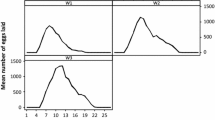Abstract
Female ticks of Ornithodoros porcinus porcinus undergo a series of adult moults when fed on blood containing eedysteroids. The supermoulted ticks are bigger, ingest larger blood meals and lay more eggs than normal females. However, their rate of conversion of blood into eggs and their oxygen uptake are reduced in comparison to normal ticks. Their ability to resorb the rehydrated salt crystals is impaired. They are unable to shed the cuticle of the Gene’s organ area leaving the organ constantly protruding, thus making the ticks vulnerable to dehydration. These factors are probably responsible for the very high mortality and the failure of most of the ticks to moult at the third supermoulting cycle.
Résumé
Les tiques femelles Ornithodoros porcinus porcinus, subissant une série de mues à l’état adulte quand elles sont nourries à du sang contenant des eedystéroides. Les tiques qui subissent plusieurs mues sont plus grosses, consomment plus de sang et pondent plus d’oeufs que les femelles normales. Cependant, leur taux de conversion du sang en oeufs et leur consommation d’oxygène est plus réduite comparée à ceux des tiques normales. Leur capacité de résorption des crystaux de sels réhydrates est réduite. Elles sont incapables de perdre la cuticule de la surface de l’organe de Géne, laissant l’organe saillant et exposant ainsi les tiques à la dehydration. Ces facteurs sont probablement résponsables de la mortalité élevée et du fait que les tiques sont incapables de ser muer au troisième cycle de super mue.
Similar content being viewed by others
References
Campbell J. D. and Oliver J. H. Jr. (1982) Membrane feeding and developmental effects of ingested B-ecdysone on Ornithodoros parkeri. In Proceedings of the VI International Congress on Acarology, Vol. 1, pp. 393–399. Halsted Press, New York.
Cox B. L. (1960) Hormonal involvement in the moulting process in the soft tick Ornithodoros turicata. Dissertation Abstract.
Ewen A. B. (1962) An improved aldehyde fuchsin staining technique for neurosecretory products in insects. Am. Microscop. Soc. Trans. 81, 94–96.
Hayes D. K., Schechter M. S., Mensing E. and Horton J. (1968) oxygen uptake of single insects determined with a polarographic oxygen electrode. Analyt. Biochem. 26, 51–60.
Hubschman J. H. (1962) A simplified azan process well suited for crustacean tissue. Stain Technol. 37, 379–380.
Humason G. L. (1962) Animal Tissue Techniques, p. 468. Freeman, San Francisco.
Kaestner A. (1968) Invertebrate Zoology, pp. 131–203. Wiley, New York.
Kitaoka S. (1972) Effects of ecdysone on ticks, especially on Ornithodoros moubata. In Abstract of the 14th Congress on Entomology, p. 272. Canberra.
Mango C. K. A. (1979) The effect of B-ecdysone and ponasterone A and the soft tick Ornithodoros porcinus porcinas. Ph.D. thesis, University of Nairobi.
Mango C. K. A. and Galun R. (1977) Ornithodoros moubata: Breeding in vitro. Expl Parasit. 42, 282–308.
Mango C., Odhiambo T. R. and Galun R. (1976) Ecdysone and the super tick. Nature, Lond. 260, 318–319.
Rudolph D. and Knülle W. (1978) Uptake of water vapour from the air: process, site and mechanism in ticks. In Comparative Physiology-Water, Ions and Fluid Mechanics (Edited by Schmidt-Nielsen K., Boliš L. and Maddrell S. H. P.). Cambridge University Press.
Savory T. H. (1964) Arachnida, pp. 47–48. Academic Press, London.
Walton G. A. (1979) A taxonomic review of Ornithodoros moubata (Murray) (Sensu Walton 1962) species group in Africa. Rec. Adv. Acarol. 2, 491–500.
Wigglesworth V. B. (1940) Control of breakdown of prothoracic gland in Rhodnius. J. exp. Biol. 163, 390–391.
Author information
Authors and Affiliations
Rights and permissions
About this article
Cite this article
Mango, C.K.A., Odhiambo, T.R., Obenchain, F. et al. The Biology of Supermoulted Female Tick Ornithodoros Porcinus Porcinus. Int J Trop Insect Sci 7, 123–128 (1986). https://doi.org/10.1017/S1742758400008833
Received:
Published:
Issue Date:
DOI: https://doi.org/10.1017/S1742758400008833




